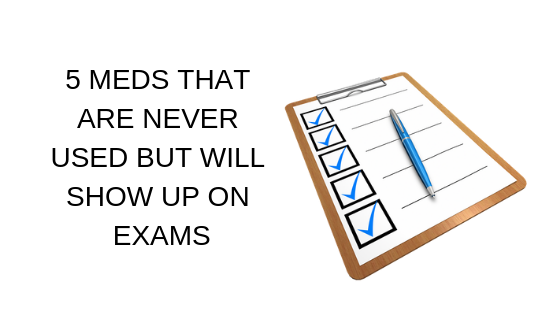If you are currently a healthcare professional, you’ll probably remember things from school that made you shake your head. Why did we learn about that, it never happens?!? I can relate with that and when I think back about my education, I remember professors teaching about and having us memorize a handful of drugs that I never (or extremely rarely) see in clinical practice. Whether you are preparing for board certification or not, I think it is wise to remember a few. If nothing else, it will help you in a pharmacy trivia game 🙂 Here’s a list of 5 medications that are never (or rarely) used but I was tested on in school.
Methyldopa
Methyldopa has always been a drug that comes up as a possibility in pregnant patients who have hypertension. While this is true, it does have some side effects like troublesome sedation and frequent dosing that are downsides to its use. I have maybe seen this drug used a couple of times in 10 years of practice.
Chlorpropamide
Chlorpropamide is a sulfonylurea that I was forced to memorize because it is one of those drugs that can cause SIADH (like carbamazepine and SSRI’s). I have never seen this medication used.
Nefazodone
Nefazodone is an older antidepressant medication that is often tested on in pharmacology and therapeutics classes due to its potential to cause liver issues. I have seen this medication used a couple of times, but not very often at all.
Ethacrynic Acid
Ethacrynic acid falls into the category of the loop diuretics. Its claim to fame and highly testable pearl is that it doesn’t have a sulfa group in its chemical structure. All of the other loop diuretics do, so in a patient with a severe type of sulfa allergy, ethacrynic acid still may be an option. It may have a little higher risk of ototoxicity. I think I have maybe seen this drug used once in my career…maybe.
Metaproterenol
Metaproterenol is a non-selective beta-agonist. Why anyone want to use this drug to open up your airways is beyond me. It can cause significant impacts on the heart (beta-1 agonism effect) by causing tachycardia. I remember learning this one in school and have never seen it used.
What other drugs do you remember learning in school, but never see in real life practice? Leave a comment below!!
- 30 medication mistakes PDF
- 18+ Page Drug Interaction PDF
- 10 Commandments of Polypharmacy Webinar based on my experiences in clinical practice
Our BCPS, BCGP, NAPLEX, and BCACP study material is ready to roll for 2019. You can find all of our resources right here!



theophylline!
Love it! and agree…I’ve only seen it a few times!
Typical of the eggheads who make up the exams!
I was a lot more pumped about ethacrynic acid as a student until this article was published. Kinda makes sense that there is more to it than just the presence of a sulfonamide group. How many patients do you see with a sulfamethoxazole allergy taking HCTZ, sumatriptan, glipizide, celecoxib, etc? This article explains why with a nice overview of medicinal chemistry and clinical application.
Wulf NR, Matuszewski KA. Sulfonamide cross-reactivity: is there evidence to support broad cross-allergenicity? Am J Health Syst Pharm. 2013 Sep 1;70(17)_1483-94. PMID 23943179